Best Internet Speed Test Apps and Sites
How Fast is Your Internet?
Do you ever wonder how fast your internet is, or if you’re getting the speeds you signed up for? Even with high-speed internet, many people across the globe struggle with slow speeds and buffering.
Speed tests are a great tool to visually see how fast, or how slow, your internet speed is. They are also a fantastic way of seeing if you are getting the speeds you’re paying your internet service provider (ISP) for, or if they’re throttling your speeds.
Here you will find everything you need to know about speed tests: what they are, how they work, and different apps and sites you can use.
We fix poor cell phone signal! Find the right signal booster for you:




What is an Internet Speed Test?
An internet speed test is a quick and easy way of testing how fast your internet connection speed is at a specific time and location. They will provide you with real-time results.
How Do Internet Speed Tests Work?
When you launch a speed test, the device conducting the test will use its location to find the closest speed test server. Different speed test websites and apps use different servers. Once the server is located, a signal will be sent to and from the server to measure the response time. The response time measures latency.
Next, the test measures download speeds. The server sends your device multiple sets of information and prompts your device to download the files. This process will measure the amount of data that was downloaded during the given time frame, providing you with the download speed.
Finally, the test measures upload speeds. Your device will upload (send) pieces of information to the server. This process will measure how much data was uploaded during the given time frame, providing you with the upload speed.
How to Read Internet Speed Test Results?
The information speed tests provide varies depending on which website or app you use. To understand the results, here are some different terms you might encounter:
- Mbps (Megabits per second) – Unit used to measure internet bandwidth.
- Bandwidth - The maximum amount of data that can be transferred over an internet connection within a specific amount of time (in this case, per second).
- Download Speed – How fast information travels from the internet to your device, it’s measured in Mbps. This is the measurement people care about the most. Higher numbers mean that your internet speed will be faster, and will better support streaming, gaming, and extensive use cases.
- Upload Speed – How fast data travels from your device to the internet, it’s measured in Mbps. Normally, upload speeds will be lower than download speeds because we tend to request more information from the internet than send information.
- Latency – The time (measured in milliseconds) it takes for a signal (ping) to travel to and from an internet server.
- Ping – The signal used to measure latency.
- Server Location – The location of the server that was used to perform the test.
- Provider – The internet provider you are using. If you don't recognize the name, it could be because you're seeing the name of the parent company your ISP falls under. For example, Xfinity internet users will see Comcast as their provider.
- IP Address – The internet protocol address of the device you are using to conduct the speed test. IP addresses provide devices a way of finding each other when sending and receiving information.
How Do I Get the Most Accurate Speed Test Results?
There are different tricks you can try to get the most accurate speed test results:
Try experimenting with the number of connected devices:
It's widely known that the number of devices connected to your WiFi network can affect your internet speeds. If possible, disconnect all of the devices connected to the internet, except for the device you will be using to run the test. This will reduce the amount of interference caused by other devices and provide you with the most accurate internet speed results. With that information, you are able to get a better understanding of the wireless speeds your ISP is providing.
To get a more realistic speed result, try to simulate what a normal day would look like. For example, if a normal day consists of you browsing the internet, someone else streaming Netflix, and another playing video games online, you will want to conduct a speed test using those variables. For more information, you can run multiple speed tests with different numbers of connected devices to see how much, or how little, they affect the speed.
Try different connections (wired and wireless):
You can try conducting a wired speed test using ethernet cables and a wireless speed test. WiFi and wired speed tests will generate different results. Things like building material, walls, furniture, and electronic devices, can interfere with WiFi signal. Ethernet cables eliminate any interference caused by obstacles and other devices. If you are testing the speeds your ISP is providing, a wired connection to the modem will give you the most accurate result.
Try conducting speed tests throughout the day:
Don’t settle for one test and call it a day. Speed tests can fluctuate, especially at different hours of the day. Perform numerous tests to get a more accurate representation of your internet speed. The results can show you if, and how much, your internet speed changes throughout the day. In addition, it can reveal if your ISP is throttling your speeds.
Try conducting speed tests in different rooms:
As we mentioned, WiFi signal can easily be interfered with. Not only do obstacles weaken the signal, but they also affect how far the signal can travel. The further you are from the router, the weaker the signal can become. Testing out the speed in the same room as the router, and in further rooms, will show you how much the speed varies throughout your home.
What are Good Internet Speed Test Results?
Good internet speed test results vary from person to person. It depends on what activities are being performed, the number of devices connected to the internet, your internet plan, and the type of internet you have.
Here is a set of common internet activities and an estimate of how many Mbps they require:
- E-Mail – 5 Mbps
- Web Browsing – 5 Mbps
- Social Media – 10 Mbps
- Video Calling – 5 Mbps to 10 Mbps
- Video/Movie Streaming – 10 Mbps for HD to 35 Mbps for 4K
- Online Gaming – 25 Mbps to 75 Mbps
- Streaming Music – 2 Mbps
- Downloading Large Files – 5 Mbps with slow download speeds to 50 Mbps with fast download speeds
For example, if you live alone and your main activities are watching Netflix (35 Mbps) and surfing the web (5 Mbps) at the same time, then a good speed test result will give you a download speed higher than 40 Mbps.
As mentioned earlier, the type of internet you have can affect your internet speed. Highspeedintenrt.com elaborates on what speeds you can expect from different types of internet.
- DSL – Typical Speed Range 10 to 25 Mbps – Max speeds up to 100 Mbps
- Cable – Typical Speed Range 50 to 100 Mbps – Max speeds up to 1,000 Mbps
- Fiber – Typical Speed Range 100+ Mbps – Max speeds up to 1,000+ Mbps
- Satellite – Typical Speed Range 15 to 25 Mbps (3 to 5 Mbps after data cap) – Max speeds up to 100 Mbps
- Fixed-Wireless – Typical Speed Range 20 to 30 Mbps – Max speeds up to 1,000 Mbps
How to Test Internet Speeds?
Testing internet speeds is very easy. There are a variety of internet speed testing apps and websites (which we will be talking about shortly) available. All you have to do is: make sure that the device you are using for the speed test is connected to your WiFi network, go to the website or app of your choosing and press the go button.
Remember, you can try the different tricks mentioned earlier to get the most accurate results.
Best Internet Speed Test Sites
SpeedTest.net by Ookla
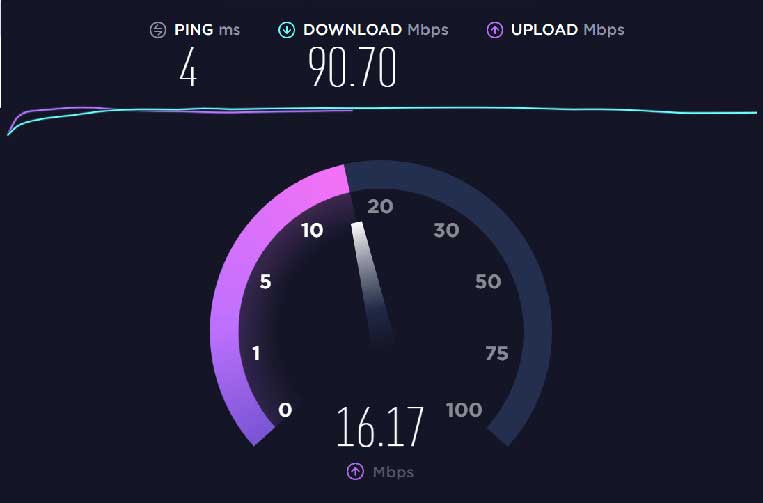
SpeedTest is one of the most popular internet speed tests available. Over 10 million tests are initiated every day. In addition, there are a lot of other test sites that use Ookla's SpeedTest to provide their users with the best results.
They have over 11,000 servers around the world to help provide more accurate speed test readings wherever you are. When running a test, your device will automatically choose the closest server, but you have the option to change it. After pressing the go button, within seconds, you will get your internets ping, download, and upload speeds.
Some people like to keep a record of their speed test results to compare them with future results. SpeedTest allows you to create an account to do just that. The stored information includes the day, time, ping measurement, download speed, upload speed, the distance between you and the server, the location of the server that was used, and your internet provider.
If you’re curious, they also provide a SpeedTest Global Index. The index shows statistics about different mobile and broadband speeds in different countries.
Visit SpeedTest.net, or download it for free on iOS, Android, Mac, Windows, Chrome, Apple TV, and CLI, to test your internet speed.
SpeedOf.me

SpeedOf.me is one of the first HTML5 speed tests created; it relies only on browser technology. You don’t have to install additional plugins like Flash or Java to get your results. This speed test is designed to work on any desktop browser and all mobile devices (iPhones, iPads, Androids, and Windows).
When accessing the site, a pop-up banner will ask you to accept cookies before you can run the test. They have over 127 servers around the world. Your device will automatically choose the closest server without the option of changing it. When you start the test, you can visually see your internet connection's speed and stability. The visual representation of the internet speed is different on the mobile version. The test will show you your download speed, upload speed, latency, and the location of the server that was used.
For those who like to keep track of their results, a history section is available.
Visit SpeedOf.me to test your internet speed.
TestMy.net

TestMy.net uses HTML5 to provide mobile and desktop users with the most accurate results. The website is very thorough, it gives you a lot of detailed information on how it works.
Once on the site, you have three options. You can choose to test download speeds, upload speeds, or an automated version. The automated option will allow you to customize how often and how long you want the speed test to run. It will automatically run the tests and save the results for future comparisons.
This speed test will provide you with more statistics than others. After running the test, the results will be displayed in two graphs. The first is a bar graph, it shows your speed results and compares them to the average speed your ISP provides, the average speed in your city, the US average speed, and more. The second is a line graph, it shows the stability of your internet connection and records the minimum, medium, and maximum speeds your internet reached during the test.
Visit TestMy.net to test your internet speed.
Bandwidth Place

Bandwidth Place is also a great speed test option. It's very simple, straight forward, and provides a lot of information on internet services.
After running the test, you will be provided with the ping measurement, download speed, upload speed, IP address, server location, and provider. This site has over 30 servers across the world. Your device will automatically choose the closest server, but you are given the option to choose. Other speed testing sites that allow you to choose a server, give you options based on which ones are closest to you. Bandwidth Place gives you the ability to choose whichever server you want, regardless of its location.
The speed results can be stored for later comparisons.
Visit Bandwidth Place to test your internet speed.
Best Internet Speed Test Apps
SpeedSmart

SpeedSmart.net uses HTML5 for accurate and fast internet testing. It’s an extremely user-friendly app, with one tap you will have your internet speed results within seconds. It tests download speeds, upload speeds, and latency.
They have over 100 speed test servers across the globe. Not only can the app test your internet speed, but also your cellular network speed. All you have to do is disconnect your device from the WiFi network and re-run the test.
The history of your internet and mobile speed tests are automatically saved in the app. The saved details include network type, date, time, download speeds, upload speeds, and latency.
Visit SpeedSmart.net, or download the app from the Apple Store or Google Play Store, to test your internet or cellular speeds.
Fast

Many people have moved away from cable to online streaming services like Netflix, Hulu, Amazon Prime, etc. One reason internet speeds are tested is to make sure they are fast enough to watch movies and shows without buffering.
Fast.com is a simple, Ad-free, speed test powered by Netflix. It uses Netflix servers to test your download speeds. The main purpose of this app is to show users if their current internet speeds can handle Netflix content without any issues. As mentioned before, to successfully stream videos, movies, and shows, you only need 10 to 35 Mbps.
When you open the app, there won’t be a button to click; the test starts automatically. Fast's biggest focus is the download speed test because it’s what will determine your video quality, hence the huge number in the middle. If you wanted a little bit more detail, you can tap the “show more info” button to see the latency and upload speeds.
Visit Fast.com, or download the app from the Apple Store or Google Play Store, to test your internet speed or cellular speeds.
SpeedCheck Internet Speed Test
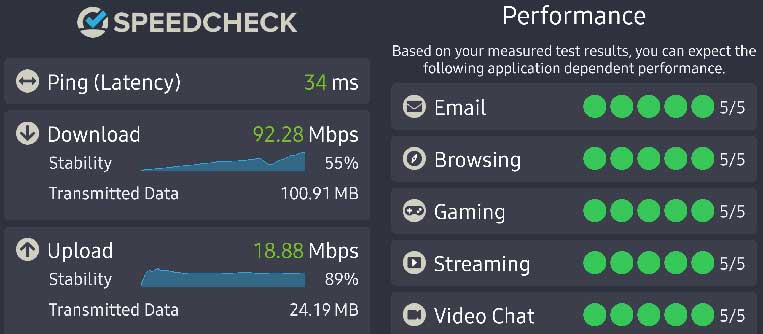
SpeedCheck is a customizable internet speed test app. With the tap of a button, you will get results on latency, download speeds, and upload speeds. While the test is running, there is a visual representation of your internet connection’s stability. If you were to turn off your WiFi, the app will also test your cellular network speeds.
A unique feature that the app offers is a performance section; it shows how good certain activities (e-mail, browsing, gaming, streaming, and video chat) will perform based on your results. You can also schedule automatic interval speed tests to refer to later.
Each test is automatically saved in the history section. The stored information includes network type, date, time, latency, download speed, and upload speed. In addition, there is an analytics section that shows you visual representations of the tests. The analytics can be filtered by day, week, month, and year, giving you an easy way to spot speed trends.
Visit SpeedChecker.org, or download the app from the Apple Store or Google Play Store, to test your internet speed or cellular speeds.
*Most mobile speed test apps can conduct cellular network and broadband speed tests.*
What Causes Slow Internet Speeds?
Did you find your internet or cellular network speeds to be better than expected, as expected, or less than satisfactory? If your speed tests were not what you expected, there are a few things that could be causing your cellular network and WiFi speeds to slow down.
WiFi speeds can be affected by:
- The number of devices connected to the internet
- The router's age or if it’s malfunctioning
- Obstacles, like walls and furniture, blocking the WiFi signal
- Internet outage caused by maintenance or severe weather
- Internet service providers throttling the connection
- Malware or viruses
The solutions for slow internet will vary based on the problem. The older routers get, the weaker they perform. Upgrading your router can improve internet speeds and bandwidth. In addition, the location of the router is extremely important, moving it to an open central location can reduce interference and improve speeds. If the issue is caused by your ISP, you will need to get in contact with them.
Cellular networks can be affected by:
- Tower distance
- Heavy cellular traffic
- Building material
- Weather
- Blocking your device's antenna
Wilson Amplifiers provides great solutions to improve your cellular network. We are one of the leading providers of cell phone signal boosters. Signal boosters are great tools that will work with any cellular carrier to improve call quality, cell phone signal, and data speeds. How? They use an external antenna to capture the weak cell signal outside, an amplifier to boost the signal (5G, 4G, and LTE), and an indoor antenna to rebroadcast the enhanced signal. As a result, you will be able to send your e-mails, browse the internet, stream videos, and access your social media without a problem.
Here is a list of some best signal booster options:
Best Signal Boosters for Homes and Vehicles
Best Signal Booster for Medium Sized Homes and Offices
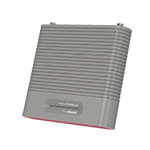
For midsize homes and offices with a strong outside signal or small homes with weak outside signal.
Buy Now at $569.99- Up to 5,000 sq ft of coverage under best conditions
- Up to +65 dB of gain, with 21 dBm uplink and 12 dBm downlink
- Multiple accessories for maximum coverage and customization (sold separately)
- Complete coverage for multiple rooms or midsize home for all carriers across multiple devices
- Outdoor yagi antenna and indoor panel antenna configuration, with stylish fabric front
The weBoost Home MultiRoom is the most popular signal amplifier with a coverage range that usually works for most people. It’s perfect for midsize homes and offices in the city with strong outside signal, or small homes in rural areas with weak outside signal.
It features a maximum uplink power of 21 dBm, meaning the booster can communicate with far distanced towers, making it a good performer in rural areas where tower distance is the biggest problem.
As its name suggests, you can expect multiple rooms of coverage or even whole-home coverage depending on your outside signal strength. Assuming you have excellent cellular signal outside your home, the Home MultiRoom can cover areas up to 5,000 sq ft, but most people will get between 2,000 – 3,000 sq ft of indoor coverage, areas with extremely poor cellular reception can expect much less coverage.
If you’re in an area where you receive next to no signal, or you want a reliable connection throughout your large home, this is the lowest grade signal booster you should get, consider its sister product, the weBoost Home Complete.
Best Professionally Installed Signal Booster for Homes and Offices
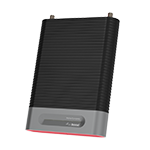
Whole-home coverage for large homes with strong outside signal or midsize homes with weak outside signal.
Buy Now at $1,499.99- Superior cell phone service for your entire home. 5G Ready
- Up to 7,500 sq. ft. to coverage under best conditions
- Up to +72 dB gain, with 24 dBm uplink and 12 dBm downlink
- Multiple accessories for maximum coverage and customization (sold separately)
- Complete coverage for entire home for all carriers across multiple devices
- Outdoor yagi antenna and indoor panel antenna, with stylish fabric front
The weBoost Installed Home Complete is the most powerful home booster you can get. It’s capable of providing whole-home coverage for a large home with strong outside signal or a midsize home with weak outside signal.
It features a maximum gain of +72 dB, which is the highest of any multi-carrier home unit, making it roughly a shade over 3x more powerful than the weBoost Home MultiRoom. And with its powerful uplink and downlink outputs, the Installed Home Complete can reach far distanced towers to provide you with superior service indoors.
Under perfect conditions, the Installed Home Complete can cover areas up to 7,500 sq ft. However, depending on your outside signal strength, most people will get between 4,000 – 6,000 sq ft, even with below average outside signal, fringe zones can expect a little less.
To maximize your coverage, additional antennas are required, especially if you’re trying to cover more than one floor. Not to mention, it features an aesthetically pleasing design to enhance your home décor rather than ruin it.
The best part of the weBoost Installed Home Complete is that it includes a professional residential installation. You won’t have to stress about installing the signal booster yourself nor trying to figure out what the best location for the signal booster is – the professionals will take care of it. However, if you would rather install the booster yourself, we also offer a Do-It-Yourself version.

Best Signal Booster for One or Two Rooms
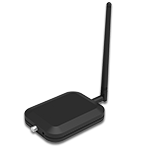
- 5G ready - Amplifies talk, text, and 5G/4G/LTE data
- Up to 2,000 sq ft of coverage under best conditions
- Up to +60 dB of gain
- Can boost multiple cellular devices across all US carriers
- Compact design, fits on any flat surface
The weBoost Home Studiois the newest and most affordable home signal booster. Perfect for people on a budget wanting to improve their cellular reception in small areas.
Under perfect conditions, it can enhance your cellular signal in areas up to 2,000 sq ft, ideal for a small home, apartment, dorm, or condo. However, coverage is determined by how strong or weak your outside signal is. Weak signal areas will probably get around 200-500 sq ft, enough to cover one large room, such as a living room, home office, master bedroom, or two small rooms.
Great starter kit if you have decent outside signal but struggle with a reliable connection in the rooms where it matters. However, if you live in a weak signal area, you're very unlikely to see the results you want and should consider an upgrade to the weBoost Home MultiRoom.
Most Powerful Multi-User Signal Booster for Vehicles
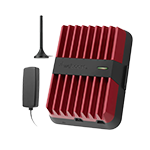
- 5G Ready - Boosts Talk, Text, and 5G/4G/LTE Data -
- Amplifies multiple cellular devices across all carriers
- Up to +50 dB gain
- Works in extremely rural and remote areas
- Extremely customizable, with variants for any type of vehicle and situation
The weBoost Drive Reach is the most powerful vehicle cell booster, designed to boost up to 4 cellular devices across all carriers. It’s the booster we highly recommend for most situations.
A mini magnet mount outside antenna picks up the signals, and a low-profile interior antenna (usually Velcroed to a seat) broadcasts the signal inside your vehicle. For optimal results, your cellular device will have to be about an arm's length from the inside antenna to benefit from the boosted signal, so it's best for your typical sedan, truck, or SUV, but will work with any vehicle.
It features the highest uplink output power of any multi-carrier vehicle booster, allowing it to reach cell towers that are 2x further for twice the signal strength, making it much more powerful than its competitors and a great performer in the most rural of roads and highways.
Best Value Signal Booster For Vehicles
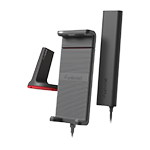
- 5G Ready - Boosts Voice, Text Messages, and 5G/4G/LTE Data
- For a single smartphone
- Cradle signal booster
- Up to +23 dB gain
The weBoost Drive Sleek is the most economical vehicle cell signal booster for a single device.
The kit includes a magnet mount antenna that can be easily installed on the roof of any vehicle and an adjustable cradle vent mount designed to hold any size smartphone or small tablet.
To benefit from the boosted signal, your cellular device has to be in the cradle. And when paired with a Bluetooth headset, it really shines for regular talk, text, and hands-free navigation.
For those extreme cases of poor cellular reception, upgrade to the weBoost Drive Reach.
Powerfull Signal Booster for RVs, Trailers, and Campers
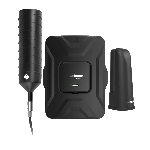
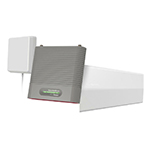
- 5G ready
- Boosts talk, text, and 5G/4G/LTE data
- Amplifies multiple cellular devices simultaneously (up to 4)
- Up to +50 dB gain
- Works with all cellular devices across all carriers (Verizon, AT&T, T-Mobile, Sprint, US Cellular, and more)
The weBoost Drive X RV is a great multi-user vehicle booster for RVs, trailers, and campers. It can be used while driving and while stationary at a campsite, so it only requires one easy installation.
This kit pairs the weBoost Drive X with the best-in-class indoor and outdoor OTR (over-the-road) antennas for improved coverage while moving.
Great for those who have a Class B camper as it should cover most of the interior space boosting signal for up to 4 phones, but can be used for Class A, Class C, and towable trailers as well. Keep in mind that the location of the inside antenna, whether you put it in the living area or the driver’s cabin, can impact which areas are being boosted. On average, the Drive X RV can provide a coverage area up to 10 ft from the inside antenna, depending on the strength of your outside signal.
If you spend most of your time in one location, consider the weBoost Destination RV as it's much more powerful than the Drive X when stationary.
Contact Us
Wilson Amplifiers is a leading provider of cellular signal boosters, devices that amplify 5G, 4G, and LTE for any phone with any carrier for home, office, or car. We’ve boosted over 10,000,000 sq ft of signal for homes, buildings, and vehicles across America and Canada.
- Free consultation (ask us anything) with our US-based customer support. Email: (sales@wilsonamplifiers.com). Phone: 1-800-568-2723.
- Free shipping. Usually ships same day.
- 90-day (seriously) money back guarantee. You want to make sure you're satisfied.
Our goal is simple: keep people connected. Ask us anything and we'll be glad to help.
Interested in Learning More? Check Out Our Signal Boosting Info Center


Money Back Guarantee

Technical Support